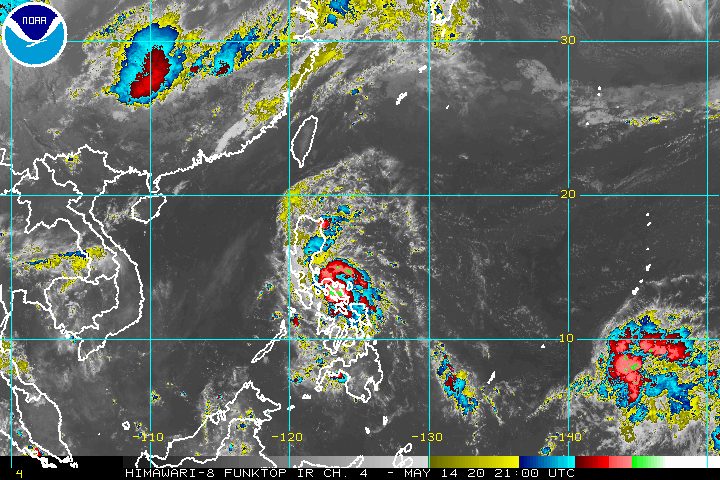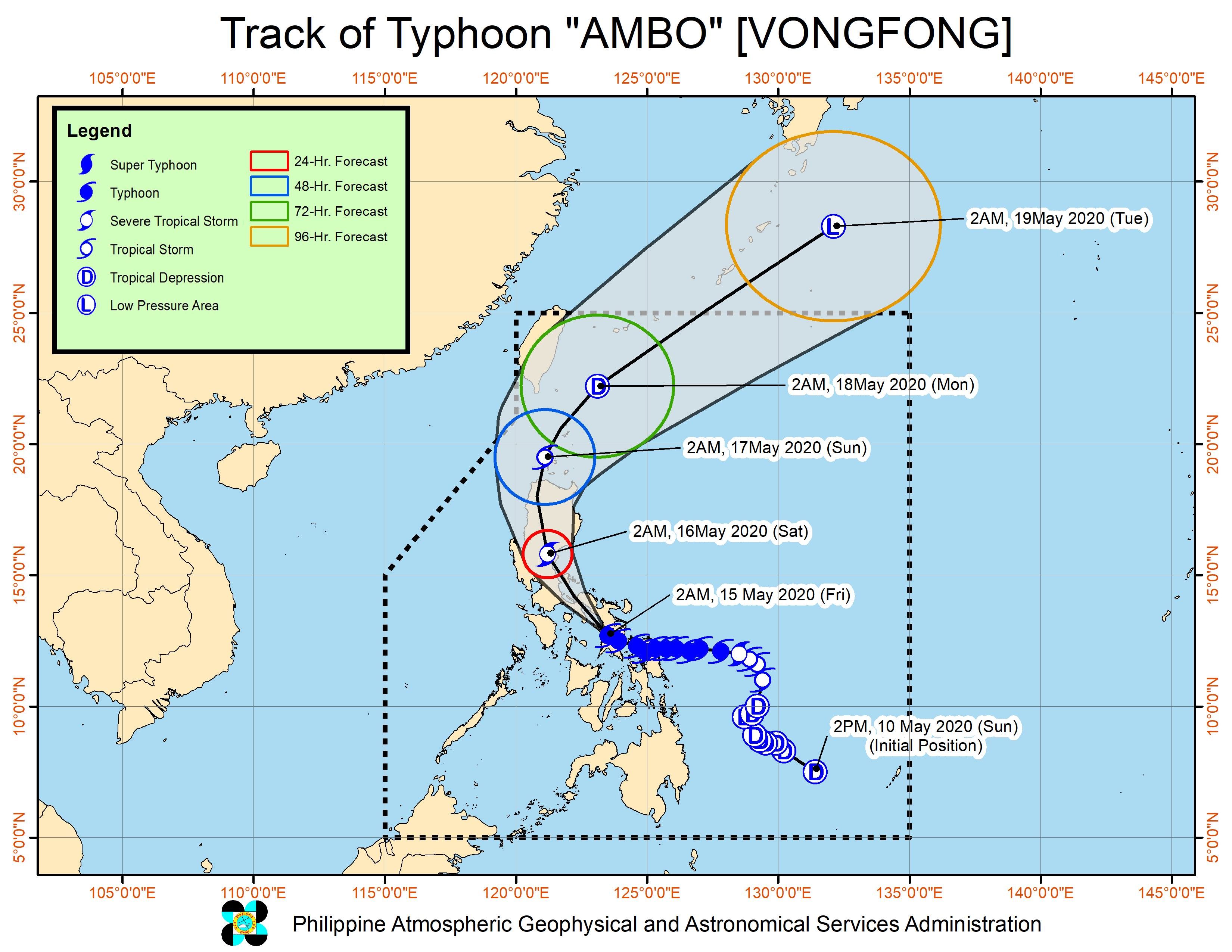SUMMARY
This is AI generated summarization, which may have errors. For context, always refer to the full article.

What’s the weather like in your area? Tweet us at @rapplerdotcom.
MANILA, Philippines – Typhoon Ambo (Vongfong) made its 5th landfall in Burias Island, Masbate, and continued to weaken before dawn on Friday, May 15.
In an online briefing past 5 am on Friday, the Philippine Atmospheric, Geophysical, and Astronomical Services Administration (PAGASA) said Ambo is already in the vicinity of the municipality of Claveria, located in Burias Island.
The typhoon has made landfall 5 times, so far:
Thursday, May 14
- San Policarpo, Eastern Samar – 12:15 pm
- Dalupiri Island, Northern Samar – 10:15 pm
- Capul Island, Northern Samar – 10:30 pm
Friday, May 15
- Ticao Island, Masbate – 12 am
- Burias Island, Masbate – 3 am
Ambo is still moving northwest at 15 kilometers per hour (km/h), heading for the Ragay Gulf. It is likely to make landfall again in the Bondoc Peninsula in the southern part of Quezon on Friday morning, said PAGASA.
Ambo’s maximum winds are now down to 125 km/h, while its gustiness decreased to 165 km/h. Its previous highs were maximum winds of 155 km/h and gustiness of up to 255 km/h on Thursday. (READ: FAST FACTS: Tropical cyclones, rainfall advisories)
There are no more areas in the Visayas under Signal No. 3 as Ambo moves upward. Below is the updated list of tropical cyclone wind signals. (READ: Why is it now called tropical cyclone ‘wind’ – and not ‘warning’ – signals?)
Signal No. 3 (winds of 121 to 170 km/h, or strong to destructive typhoon-force winds during the passage of the typhoon)
- Sorsogon
- Albay
- northern part of Masbate (Aroroy, Mandaon, Milagros, Baleno, Masbate City, Mobo, Uson) including Ticao Island and Burias Island
- Camarines Norte
- western part of Camarines Sur (Del Gallego, Ragay, Lupi, Sipocot, Libmanan, Cabusao, Pasacao, Pamplona, Gainza, Camaligan, Canaman, Magarao, Bombon, Calabanga, Tinambac, Siruma, Goa, Naga City, Milaor, San Fernando, Minalabac, Pili, Ocampo, Tigaon, Sagñay, Buhi, Iriga City, Baao, Bula, Balatan, Nabua, Bato)
- southern part of Quezon (Pagbilao, Atimonan, Padre Burgos, Agdangan, Plaridel, Unisan, Gumaca, Pitogo, Perez, Alabat, Quezon, Tagkawayan, Calauag, Lopez, Macalelon, General Luna, Catanauan, Buenavista, Guinayangan, Mulanay, San Narciso, San Andres, San Francisco)
Signal No. 2 (winds of 61 to 120 km/h, or strong to damaging gale-/storm-force winds during the passage of the typhoon)
- Nueva Vizcaya
- Quirino
- Aurora
- Nueva Ecija
- Tarlac
- Pampanga
- Bulacan
- Metro Manila
- Rizal
- Laguna
- Cavite
- Batangas
- rest of Quezon
- rest of Masbate
- rest of Camarines Sur
- Catanduanes
- eastern part of Romblon (Banton, Corcuera, Calatrava, San Agustin, Romblon, Magdiwang, San Fernando, Cajidiocan)
- western part of Northern Samar (San Vicente, Capul, San Antonio, Allen, Victoria, San Isidro, Biri, Lavezares, Rosario, San Jose)
Signal No. 1 (winds of 30 to 60 km/h, or strong to near-gale-force winds during the passage of the typhoon)
- Cagayan including Babuyan Islands
- Isabela
- Ilocos Norte
- Ilocos Sur
- La Union
- Pangasinan
- Apayao
- Kalinga
- Abra
- Mountain Province
- Ifugao
- Benguet
- Zambales
- Bataan
- Oriental Mindoro
- rest of Romblon
- rest of Northern Samar
- extreme northern part of Eastern Samar (Jipapad, Arteche, Maslog)
- northern part of Samar (Calbayog City, Tagapul-an, Almagro, Sto Niño, Tarangnan, Sta Margarita, Gandara, Pagsanghan, San Jorge, San Jose de Buan, Matuguinao)
- Biliran
- extreme northwestern part of Leyte (Calubian, San Isidro)
- extreme northeastern part of Capiz (Pilar, Panay, Roxas, Ivisan)
- northeastern part of Iloilo (Carles, Balasan, Estancia, Batad)
In terms of rain, here’s what to expect from Ambo in the next two days:
Friday, May 15
Moderate to heavy rain, with at times intense rain
- Bicol
- Quezon
- Aurora
- Marinduque
Saturday, May 16
Moderate to heavy rain, with at times intense rain
- Cagayan Valley
- Apayao
- Kalinga
- Mountain Province
- Ifugao
- Aurora
- northern part of Nueva Ecija
Floods, landslides, and even lahar from Mayon Volcano are possible. The Philippine Institute of Volcanology and Seismology issued an advisory on Wednesday, May 13, warning that rainfall from Ambo might mix with volcanic deposits from Mayon’s 2018 eruption, which could result in lahar or volcanic mudflows.
The typhoon may also cause storm surges up to 2 meters high in the next 24 hours, which might lead to “potentially life-threatening coastal inundation.” These areas should watch out for possible storm surges:
- Bicol
- Quezon
- Aurora
Sea travel remains risky for all vessels in the seaboards of areas under tropical cyclone wind signals.
Ambo is expected to leave the Philippine Area of Responsibility on Monday, May 18. By then, it is likely to have weakened already into a tropical depression.

Ambo is the Philippines’ first tropical cyclone for 2020. The country gets an average of 20 tropical cyclones per year. (READ: LIST: PAGASA’s names for tropical cyclones in 2020)
In PAGASA’s climate outlook, it gave the following estimates for the number of tropical cyclones in the next 6 months:
- May – 1 or 2
- June – 1 or 2
- July – 2 to 4
- August – 2 or 3
- September – 2 or 3
- October – 2 or 3
Ambo’s arrival comes as the Philippines faces the coronavirus outbreak, with 11,876 cases as of Thursday. (READ: Social distancing ‘per family’ at Typhoon Ambo evacuation centers) – Rappler.com
Add a comment
How does this make you feel?
There are no comments yet. Add your comment to start the conversation.